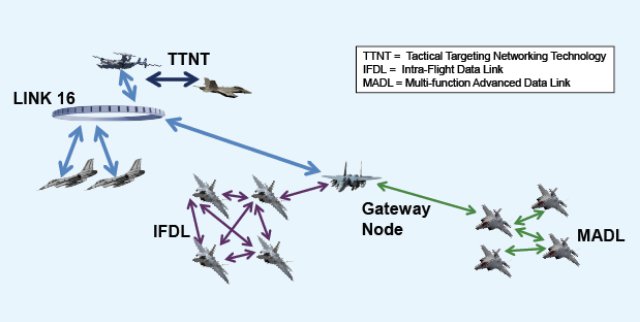DARPA solicits proposals to enable manned and unmanned air systems to rapidly, securely, and automatically share information across diverse waveforms and networks despite adversary jamming.
Modern airborne warfare is becoming increasingly complex, with manned and unmanned systems having to rapidly share information in a volatile environment where adversaries use advanced, commercially available electronic systems to disrupt U.S. and allied communications. Complicating the communications challenge for allied warfighters, many current airborne radio networks are incompatible with each other, the result of security and radio frequency (RF) format differences between aircraft types. Specialized data-link gateways facilitate communication across network divides, but these gateways have limited capability and don’t allow high-data-rate information to flow freely and seamlessly among multiple types of manned and unmanned aircraft.
With an eye toward overcoming this increasingly critical challenge, DARPA today published the Broad Agency Announcement solicitation for its Dynamic Network Adaptation for Mission Optimization (DyNAMO) program. DyNAMO seeks novel technologies that would enable independently designed networks to share information and adapt to sporadic jamming and mission-critical dynamic network bursts in contested RF environments. The program seeks technology that can interconnect existing static networks and be able to connect future adaptive networks as well. The solicitation is available here: http://go.usa.gov/3JGgR.
“Current airborne networks are not designed to handle the complexities of modern distributed and dynamic combat missions, and the challenge is only going to increase in the years ahead,” said Wayne Phoel, DARPA program manager. “DyNAMO’s goal is to enable pilots in one type of aircraft with a specific suite of sensors to easily share information with different types of manned and unmanned systems and also receive sensor information from those various platforms for a comprehensive view of the battlespace. We aim to develop technology that dynamically adapts networks to enable instantaneous free-flow of information among all airborne systems, at the appropriate security level and in the face of active jamming by an adversary.”
The network technology developed through the DyNAMO program is to be demonstrated on radio hardware being developed by DARPA’s Communications in Contested Environments (C2E) program. C2E is designing flexible new development architectures so aircraft won’t be limited to communicating with aircraft using the same radio and waveform. C2E also aims to leverage the proven commercial smart-phone architectural model in which the application processing, real-time processing, and hardware functions of a software-defined radio are separately managed, validated, and updated to ensure rapid deployment of capabilities. DyNAMO is designed to pick up where C2E leaves off, ensuring that raw RF data successfully communicated between previously incompatible airborne systems is not only conveyed but also translated into information that all the systems can understand and process, whether that information relates to time-sensitive collaborative targeting, imagery or networked weapons.
Proposers interested in the program may read details in the Broad Agency Announcement (BAA) solicitation on FedBizOpps here: http://go.usa.gov/3JGgR
Source: Press Release

